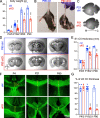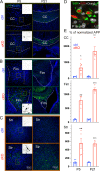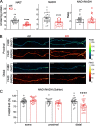NMNAT2 supports vesicular glycolysis via NAD homeostasis to fuel fast axonal transport
- PMID: 38282024
- PMCID: PMC10823734
- DOI: 10.1186/s13024-023-00690-9
NMNAT2 supports vesicular glycolysis via NAD homeostasis to fuel fast axonal transport
Abstract
Background: Bioenergetic maladaptations and axonopathy are often found in the early stages of neurodegeneration. Nicotinamide adenine dinucleotide (NAD), an essential cofactor for energy metabolism, is mainly synthesized by Nicotinamide mononucleotide adenylyl transferase 2 (NMNAT2) in CNS neurons. NMNAT2 mRNA levels are reduced in the brains of Alzheimer's, Parkinson's, and Huntington's disease. Here we addressed whether NMNAT2 is required for axonal health of cortical glutamatergic neurons, whose long-projecting axons are often vulnerable in neurodegenerative conditions. We also tested if NMNAT2 maintains axonal health by ensuring axonal ATP levels for axonal transport, critical for axonal function.
Methods: We generated mouse and cultured neuron models to determine the impact of NMNAT2 loss from cortical glutamatergic neurons on axonal transport, energetic metabolism, and morphological integrity. In addition, we determined if exogenous NAD supplementation or inhibiting a NAD hydrolase, sterile alpha and TIR motif-containing protein 1 (SARM1), prevented axonal deficits caused by NMNAT2 loss. This study used a combination of techniques, including genetics, molecular biology, immunohistochemistry, biochemistry, fluorescent time-lapse imaging, live imaging with optical sensors, and anti-sense oligos.
Results: We provide in vivo evidence that NMNAT2 in glutamatergic neurons is required for axonal survival. Using in vivo and in vitro studies, we demonstrate that NMNAT2 maintains the NAD-redox potential to provide "on-board" ATP via glycolysis to vesicular cargos in distal axons. Exogenous NAD+ supplementation to NMNAT2 KO neurons restores glycolysis and resumes fast axonal transport. Finally, we demonstrate both in vitro and in vivo that reducing the activity of SARM1, an NAD degradation enzyme, can reduce axonal transport deficits and suppress axon degeneration in NMNAT2 KO neurons.
Conclusion: NMNAT2 ensures axonal health by maintaining NAD redox potential in distal axons to ensure efficient vesicular glycolysis required for fast axonal transport.
© 2024. The Author(s).
Conflict of interest statement
All authors declare they have no competing interests.
Figures








Update of
-
NMNAT2 supports vesicular glycolysis via NAD homeostasis to fuel fast axonal transport.Res Sq [Preprint]. 2023 May 19:rs.3.rs-2859584. doi: 10.21203/rs.3.rs-2859584/v1. Res Sq. 2023. Update in: Mol Neurodegener. 2024 Jan 29;19(1):13. doi: 10.1186/s13024-023-00690-9. PMID: 37292715 Free PMC article. Updated. Preprint.
References
MeSH terms
Substances
Grants and funding
LinkOut - more resources
Full Text Sources
Molecular Biology Databases
Research Materials

